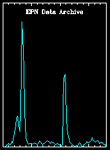|

from
JodrellBankCentreForAstrophysics
Website
What is a pulsar?
A pulsar is a highly magnetized neutron star, with a radius of 10-15
km, having somewhat greater mass than the Sun which has a radius of
approximately 1 million km.
Radiation is beamed out along the
magnetic poles and pulses of radiation are received as the beam
crosses the Earth, in the same manner as the beam from a lighthouse
causes flashes. Being enormous cosmic flywheels with a tick
attached, they make some of the best clocks known to mankind.
These sounds are from the brightest
pulsars in the sky, recorded using some of the largest
radio-telescopes in the world.
|
|
 PSR
B0329+54 PSR
B0329+54
This pulsar is a typical, normal pulsar, rotating with a
period of 0.714519 seconds, i.e. close to 1.40
rotations/sec. |
|
|
 PSR
B0833-45, The Vela Pulsar PSR
B0833-45, The Vela Pulsar
This pulsar lies near the centre of the Vela supernova
remnant, which is the debris of the explosion of a
massive star about 10,000 years ago.
The pulsar is the collapsed
core of this star, rotating with a period of 89
milliseconds or about 11 times a second. |
|
|
 PSR
B0531+21, The Crab Pulsar PSR
B0531+21, The Crab Pulsar
This is the youngest known pulsar and lies at the centre
of the Crab Nebula, the supernova remnant of its birth
explosion, which was witnessed by Europeans and Chinese
in the year 1054 A.D. as a day-time light in the sky.
The pulsar rotates about 30
times a second. |
|
|
 PSR
J0437-4715 PSR
J0437-4715
This is a recently discovered millisecond pulsar, an old
pulsar which has been spun up by the accretion of
material from a binary companion star as it expands in
its red giant phase.
The accretion process
results in orbital angular momentum of the companion
star being converted to rotational angular momentum of
the neutron star, which is now rotating about 174 times
a second. |
|
|
 PSR
B1937+21 PSR
B1937+21
This is the second fastest known pulsar, rotating with a
period of 0.00155780644887275 seconds, or about 642
times a second.
The surface of this star is
moving at about 1/7 of the velocity of light and
illustrates the enormous gravitational forces which
prevent it flying apart due to the immense centrifugal
forces.
The fastest-rotating pulsar
is PSR J1748-2446ad, which rotates about 10% faster at
716 times a second. |
|


 PSR
B0329+54
PSR
B0329+54 PSR
B0833-45, The Vela Pulsar
PSR
B0833-45, The Vela Pulsar PSR
B0531+21, The Crab Pulsar
PSR
B0531+21, The Crab Pulsar PSR
J0437-4715
PSR
J0437-4715 PSR
B1937+21
PSR
B1937+21